
“Crouching Tiger, Hidden Dragon” is a poetic expression drawn from classical Chinese idiom, and it encapsulates a deeper philosophy embedded throughout the story. Beneath its surface of martial arts spectacle and tragic romance lies a commentary on restraint, concealed power, and unspoken desire.
Origins of the Phrase
The phrase comes from the Chinese idiom “卧虎藏龙” (wò hǔ cáng lóng), which literally translates to “crouching tiger, hidden dragon”. It refers to talented individuals who remain unnoticed or choose to hide their true abilities. In ancient literature, the expression often suggested that behind the calm or ordinary exterior of a place or person, there may lie untapped greatness, danger, or complexity.
Ang Lee’s decision to retain the phrase in its untranslated form for international audiences was deliberate. It preserves the ambiguity and poetic weight that would be lost in a direct translation. To a Chinese-speaking audience, the title signals a world where nothing is quite as it seems, where mastery and emotion exist beneath layers of silence and self-denial.
Application to the Characters
Li Mu Bai and Yu Shu Lien are the clearest representations of the phrase. Both are warriors of extraordinary skill, yet both are bound by duty and repression. Mu Bai yearns to leave the path of violence behind, but he is pulled back by unfinished matters and emotional conflict. Shu Lien suppresses her feelings out of loyalty and honour, burying her desires beneath the surface.
Jen Yu, however, embodies the more volatile side of hidden potential. She is young, brilliant, and deeply conflicted. Her dual life, dutiful aristocrat by day, masked thief by night, mirrors the idiom. The tiger and dragon in her are not merely hidden; they are struggling for control. She seeks freedom, yet does not fully grasp the consequences of unleashing her abilities without discipline or reflection.
Broader Themes
The film plays with the tension between inner restraint and outward action. Its central characters wrestle not only with enemies but with themselves. Their conflicts are not just physical; they are moral, emotional, and spiritual. The hidden dragons and crouching tigers are internal forces, ambition, love, anger, sorrow, that must either be tamed or accepted.
Ang Lee’s direction highlights this tension through long silences, moments of stillness, and lingering gazes. The famous fight scenes are not mere choreography; they are expressions of personal struggle. Each clash is laced with subtext, revealing what the characters cannot say aloud.
A Title That Reflects the Film’s Core
“Crouching Tiger, Hidden Dragon” is the key to understanding the film’s deeper intentions. It asks viewers to look beyond the visible, to recognise that power often comes disguised, that passion can be silenced but not erased, and that true strength may lie in the choice to hold back.
The idiom, like the film, leaves room for reflection. It acknowledges that life often conceals more than it reveals, and that people carry hidden parts of themselves the world may never see. That is the real heart of the title, and of the story it frames.



